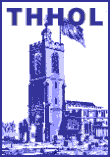Here, in a remote period, veiled in the mist of antiquity, some folks came and settled on the rising ground alongside the River Lee; and in the course of time the cluster of homesteads that arose formed a hamlet of the parish of Stepney. It was known as Stratford, a name derived from the street or paved way to a ford; the crossing, however, being practicable only at times in consequence of the river being often in flood. To the banks on either side the name was applied, but after the building of the bow-shaped bridge when the highway was diverted from Old Ford to this place, the Essex side of the bridge was distinguished as Stratford Langthorne, from the Abbey of Langthorne in West Ham, and the Middlesex side was identified with the bridge itself and became described as Stratford-atte-(at the) Bow, and later Stratford Bow, and finally, Bow.
The church of St. Mary Stratford Bow, as it is still ecclesiastically called, was consecrated in 1719 on its separation from its mother church of Stepney, to which it had been a chapel of ease. Six hundred years ago, in 1311, a licence was granted by the Bishop of London to the inhabitants of Bow "to build a chapel for being so far distant from the parish church and the roads in winter being impassable by reason of the floods," and this was carried out, Edward III granting for the purpose a piece of land on what was the King's highway. The terms of episcopal licence provided that the inhabitants should attend Stepney Church on all great holidays, and contribute towards its repairs. To put an end to the many disputes that ensued, the inhabitants, in 1475, compounded by paying 24s. per annum in respect of the repairs and acknowledging their church to be a chapel of ease to Stepney by agreeing to attend there on St. Dunstan's Day, and to join the parishioners of Stepney on the Wednesday next after Pentecost in their procession to St. Paul's. This annual excursion in Whitsun week may or may not have been the cause of local rejoicing and revelry, yet it is a curious fact, believed to be unnoticed hitherto, that on the following day was held Bow Fair, or, as it was called in olden days, "Green Goose Fair." Taylor, the water-poet, wrote in 1630:
"At Bow, the Thursday after Pentecost,
There is a fair of green geese ready rost,
Where, as a goose is ever dog cheap there
The sauce is over somewhat sharp and deare."
And he then proceeded to make not a few uncomplimentary allusions to the conduct and behaviour of the crowd resorting there. This fair, abolished some seventy years ago, was held near the church, the locality being indicated by Fairfield Road.
Until a hundred years ago the church was not in sole posssession of the island site it occupies to-day. Formerly at the east end, adjoining the brick wall of the narrow graveyard, stood Sir John Jolles' school - a gabled building - and a small market-place where there was a cage, or lock-up, for law-breakers; and at the west end, screening the church from the view of those approaching it from London, were seven ancient tenements. The Essex highway passing the south side of the church formed the village street with its inns and shops, while on the north side of the church, on the way leading to Old Ford, were the residential houses.
 In
the picture [left] there can be seen the last two of the seven tenements to which reference
has been made, in the course of demolition; and on the turret of the church tower the beacon
irons which were not replaced after the upper part of the belfry fell in 1829. There are a number
of figures and effects included in the picture by A. W. Callcott, R.A., for the purpose of composing
a pictorial description of the village on a sunny afternoon with passing clouds - ten minutes
to five by the church clock - in September 1826.
In
the picture [left] there can be seen the last two of the seven tenements to which reference
has been made, in the course of demolition; and on the turret of the church tower the beacon
irons which were not replaced after the upper part of the belfry fell in 1829. There are a number
of figures and effects included in the picture by A. W. Callcott, R.A., for the purpose of composing
a pictorial description of the village on a sunny afternoon with passing clouds - ten minutes
to five by the church clock - in September 1826.
by Sydney Maddocks
